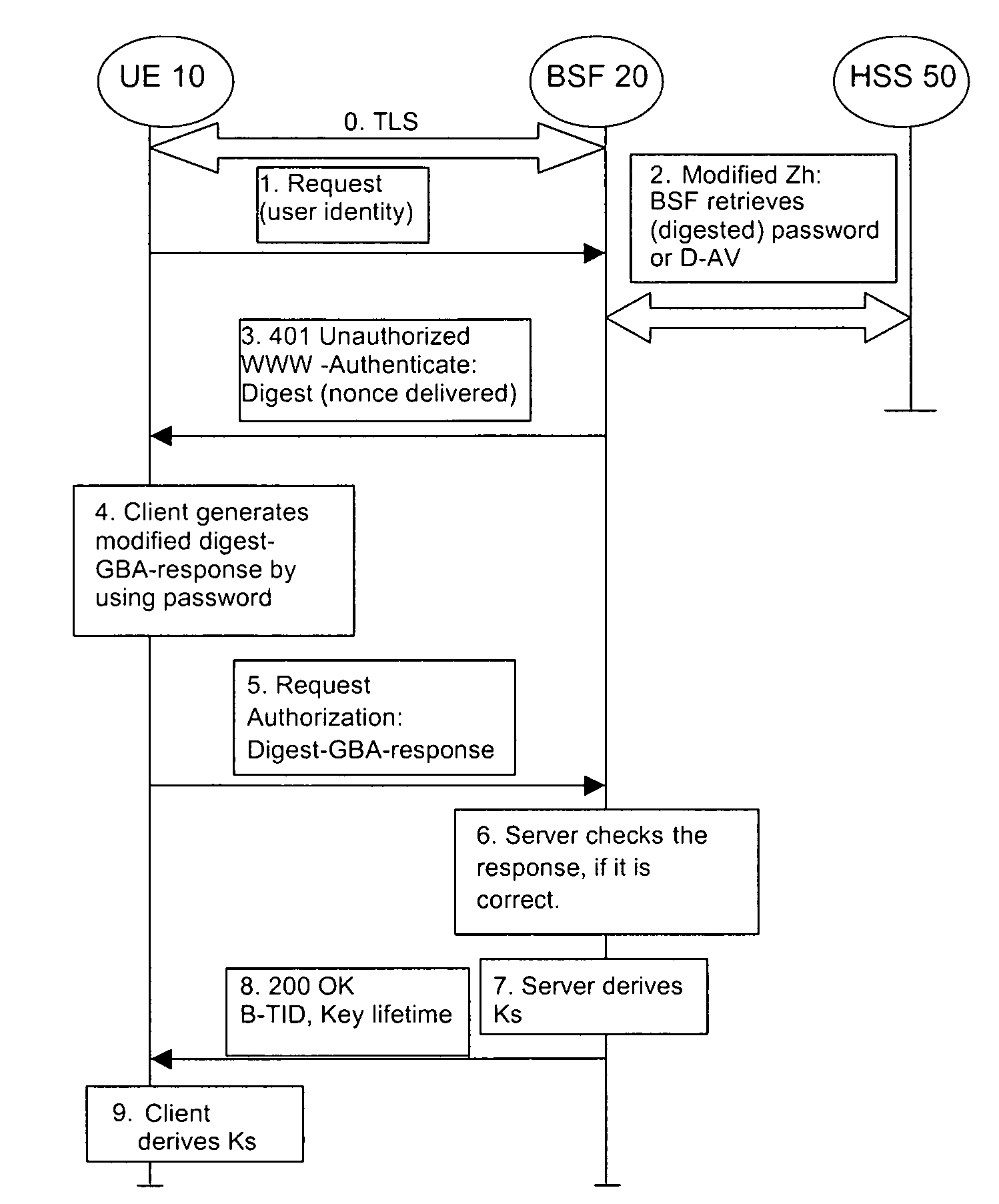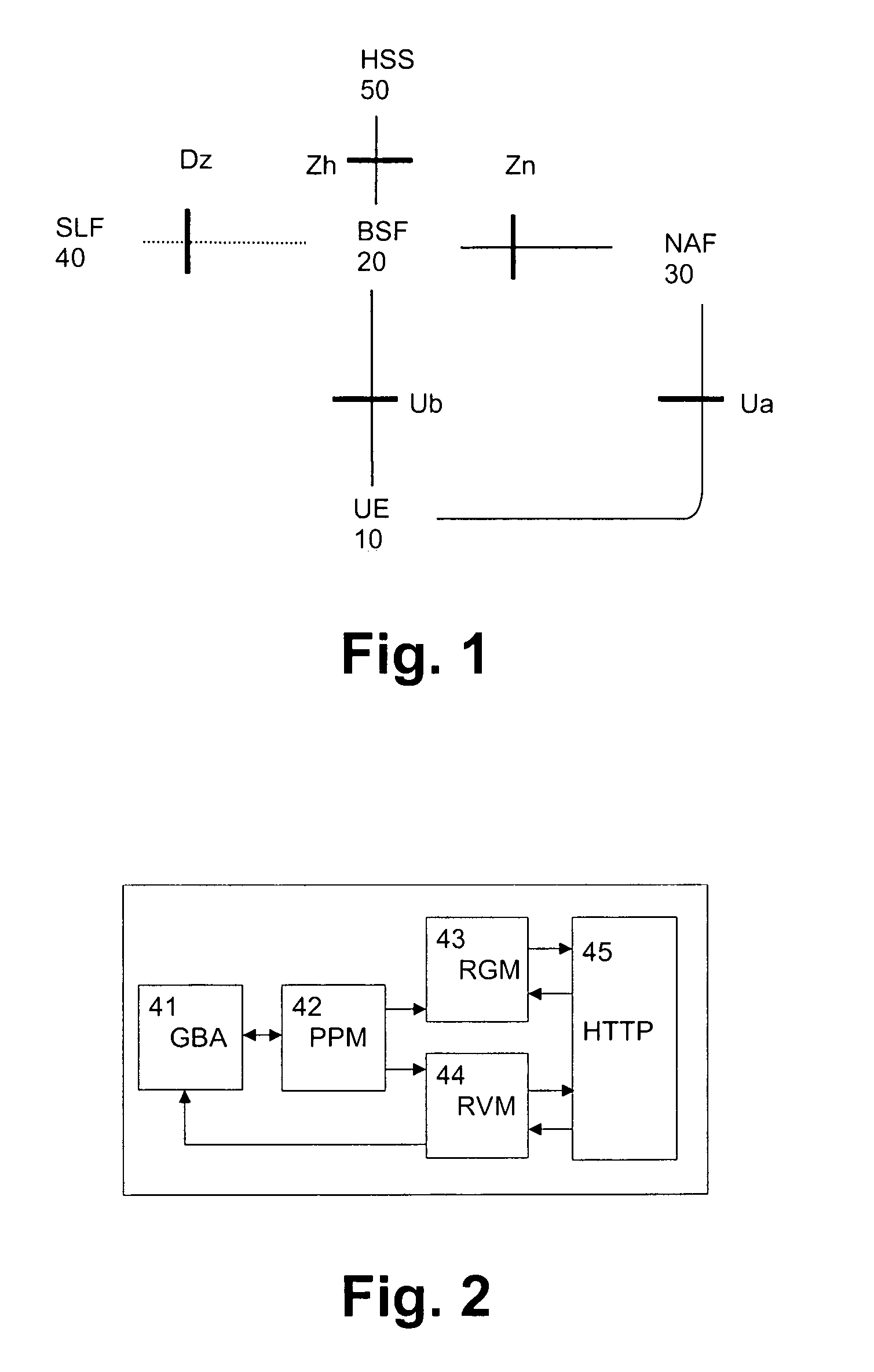Secure Bootstrapping Architecture Method Based on Password-Based Digest Authentication
a digest authentication and secure technology, applied in the field of performing authentication, can solve the problems of gba_h mechanism being vulnerable to a main-in-the-middle (mitm) attack, virtually impossible replay attack, and unable to introduce user identity modules for customers, etc., to achieve the effect of enhancing security and cleaning the overall architectur
- Summary
- Abstract
- Description
- Claims
- Application Information
AI Technical Summary
Benefits of technology
Problems solved by technology
Method used
Image
Examples
first embodiment
[0046] the protocol on the Ub interface is modified so that—instead of returning a parameter digest-response=H(user name, password, nonce, . . . ), as specified in the conventional HTTP digest (where H is a hash function, e.g. MD-5)—the UE 10 returns a parameter digest-GBA-response=H*(digest-response, password, . . . ) to the BSF 20, where digest-response is the conventional HTTP digest-response and H* is another hash function (e.g. the key derivation function (KDF) used in GBA). This way proper user involvement is ensured, so that the MITM does not know the password.
[0047]FIG. 3 shows an exemplary and schematic processing and signaling diagram of the first embodiment.
[0048]In an initial step 0 the UE 10 starts the bootstrapping procedure by initiating a TLS session with the BSF 20. The UE 10 and the BSF 20 negotiate a server-side only authenticated TLS. The UE 10 authenticates the BSF 20 by a certificate presented by the BSF 20. The BSF 20 does not require authentication from the U...
second embodiment
[0059] it is ensured that the GBA key Ks is a function of a fresh parameter, i.e. a parameter not used in a previous protocol run, exchanged over the encrypted TLS connection between the user and the BSF 20.
[0060]According to a first implementation example of the second embodiment, freshness can be achieved through a combination of the two parameters nonce and cnonce. Use of the nonce parameter (a value uniquely generated by the server and used as challenge for the client) guarantees freshness of the GBA key Ks to the BSF 20. Additionally, use of the cnonce parameter (a value uniquely generated by the client that here adds the freshness to the GBA key Ks) guarantees freshness of the GBA key Ks to the user (client). As an implementation example, the GBA key Ks could be derived based on the following equation:
Ks=KDF(“3gpp-gba-ks-digest”,nonce,cnonce, . . . )
[0061]According to a second implementation example, the password and the parameter digest-response can be used instead of the non...
third embodiment
[0064]FIG. 5 shows a schematic signaling and processing diagram in which the use of TLS can be dropped to thereby make the solution very simple. However, a breach of the password can make all past GBA keys Ks known if the bootstrappings on the Ub interface were recorded by an attacker.
[0065]It is assumed that the BSF 20 is authenticated by means of the mutual authentication, i.e. by using the response-digest parameter in the authentication information header, e.g. as specified in RFC 2617. Thus, most steps of FIG. 5 correspond to those of FIG. 4 with the exception that the TLS step 0 has been omitted. However, the derivation of the GBA key Ks in steps 7 and 9 is further enhanced by ensuring that a shared secret, i.e. the password, is involved. Thus, the GBA key Ks may be calculated by using the following equation:
Ks=H*(“3gpp-gba-ks-digest”,password,nonce,cnonce, . . . ).
[0066]More specifically, where the hashing function is the KDF and no further parameters are involved, the equati...
PUM
 Login to View More
Login to View More Abstract
Description
Claims
Application Information
 Login to View More
Login to View More - R&D
- Intellectual Property
- Life Sciences
- Materials
- Tech Scout
- Unparalleled Data Quality
- Higher Quality Content
- 60% Fewer Hallucinations
Browse by: Latest US Patents, China's latest patents, Technical Efficacy Thesaurus, Application Domain, Technology Topic, Popular Technical Reports.
© 2025 PatSnap. All rights reserved.Legal|Privacy policy|Modern Slavery Act Transparency Statement|Sitemap|About US| Contact US: help@patsnap.com



